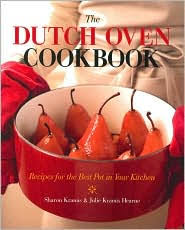Cast iron cookware has been around for hundreds of years. Centuries ago, cast iron kettles and skillets were used over open fires in Europe. They were one of the very few treasured items that settlers brought with them to the New World.
Cast iron pans are formed through the process of sand-casting. Molten iron is poured into a sand-clay mold of the desired shape,. After it cools, the mold is removed and the pan's surface is smoothed by a stone-washing process. Although pioneer cast iron companies, Griswold Manufacturing and Wagner Manufacturing, are no longer in business, you can occasionally discover them at secondhand stores. They are a great find. Well-seasoned and well-used, they are my favorite!
Often, cooks who are unfamiliar with cast iron are pleasantly surprised to find that well-seasoned cast iron has a perfect nonstick surface. Teflon-coated and stainless steel pans tend to cause food to "sweat" which stews and toughens meat instead of browning it, and prevents a crisp crust from forming. Food cooked in cast iron doesn't sweat. Cast iron pans heat quickly and evenly and maintain their heat. They provide an even exchange of heat with the food, thus allowing meats to brown and caramelize, staying tender. The high heat of the pan forms golden crusts on baked goods and acts just like a wood-fired oven for pizzas and breads.
Nowadays most new cast iron pans come preseasoned which means you can use them right out of the box. (For cast iron, the point of "seasoning" is to bake the fat into the pan's porous surface to create a smooth, permanent nonstick coating and to prevent rust.) However, it's a good idea to re-season your pan every so often. Show your cast iron pan some good use and love, and it will thank you with increasingly complex, mature, and unforgettable flavors!
Saturday, December 20, 2008
Subscribe to:
Post Comments (Atom)






No comments:
Post a Comment